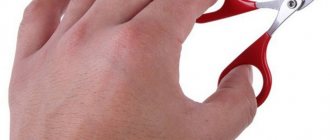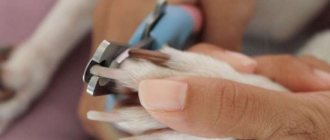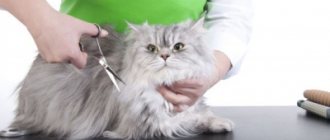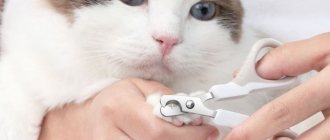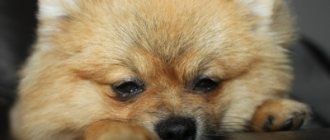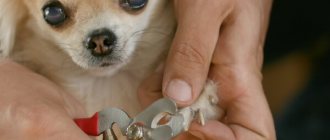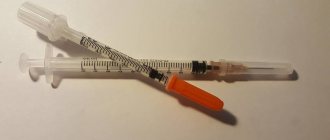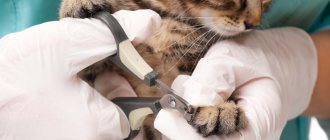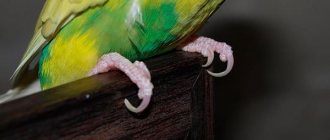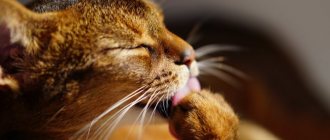Why do you need to cut your hair?
Nature has taken care of every living creature, and a cat’s claws were not given for beauty. In natural habitats, claws help a cat hunt for prey and escape from stronger opponents. With the help of its claws, the animal easily climbs a tree, escaping the dog and other enemies. But why do they need a domestic cat, who sees the whole world only from the apartment window?
Many owners believe that claws only bother a cat. And you can’t count how many troubles they cause for owners of furry pets:
- cling to carpets, curtains, upholstered furniture;
- During games, they can accidentally or deliberately scratch or injure a person.
Untrained cats often mistake a sofa, armchairs or carpet for a scratching post. And even if you place scratching posts in every room, the pet will leave marks of sharp claws on the furniture. There is only one way out - trim the claws so that they are not so sharp.
For animals participating in exhibitions, trimming their nails is a mandatory procedure. It is also recommended to do this:
- before mating;
- a visit to the veterinarian.
Small kittens, although they still have softer claws than adult cats, are also recommended to trim them so as not to injure the mother cat during feeding, and at the same time accustom them to manipulation. The sooner this is started, the less resistance the owner will encounter from the pet later during cosmetic procedures.
Important!
In no case should the claws of cats that have the opportunity to walk outside be trimmed: this can deprive them of the ability to defend themselves, which can lead to serious injuries and even death of the pet.
Is it possible to cut a cat's claws - pros and cons
So, is it worth trimming a cat’s claws and how to do it. Positive aspects:
- Pets are not able to sharpen their claws to the required length themselves. They grow very long in cats, this can easily lead to their ingrowth into the pads and delamination. If you don't trim your cats' claws, they will eventually interfere with their ability to move, regularly clinging to carpets, furniture and everything else.
- The need to trim nails most often arises only when they are very peeling or very injured.
- Quite often, before owners decide to trim their cat’s claws, they have time to say goodbye to the upholstery on the sofa, wallpaper in the bedroom, parquet flooring and jambs. All these things were ruined by the cat, and when guests arrive you can immediately see who’s boss.
- If there are children in the house, then the question of whether or not to cut the cat’s claws disappears by itself. Because a constantly scratched child leaves no choice for his parents.
- Before exhibitions, nail trimming is mandatory. This is an argument for those who own elite or purebred animals.
Opponents of this procedure provide no less weighty arguments:
- Even if the owner is fluent in the art of trimming cats' claws, injury cannot be avoided. Because the keratinized part is two or three millimeters long. After an injury, the claw can easily become infected.
- The nail trimming procedure itself can be very painful for a pet, since the claws contain all the nerve endings. Even if you know how to trim her nails correctly, be very careful because she will not have the best memories of the procedure. And this will need to be done regularly.
- Immediately after the claws are trimmed, they become less functional, and it will be very difficult for your beloved pet to cling to various objects. The animal will not immediately understand its limitations; it may try to jump somewhere and not be able to resist. So is it okay to have your cat's nails trimmed if it increases the risk of injury to your pet?
- After your pet has undergone this procedure once, you will have to do it regularly, twice a month.
- Now think about what will be more annoying, unpleasant periodic procedures or scratched furniture?
Tools and materials
Today, pet stores and veterinary pharmacies are not uncommon; there are even in remote villages. There you can buy all the necessary equipment and accessories for caring for cats. Specialists will select any tool and answer questions regarding nail trimming.
For a cat manicure you will need:
- claw cutter - guillotine or pruning type pliers, with sharply sharpened blades. A blunt instrument can hit special areas and cause pain;
- nail cutter - scissors similar to a manicure device, but made to resemble a cat’s claw;
- grinder - a device in the form of a ballpoint pen with a small rotating rod that grinds down the hard tissue of the claw at high speed;
- sanding file;
- hair clipper. If the pet has long hair, then the hair between the toes must be cut off. For animals that cannot stand the sound of a working device, fur can be removed using ordinary scissors;
- antiseptic and hemostatic agent (for example, hydrogen peroxide, iodine). May be useful in case of accidental damage to the soft part of the claw;
- baby talc - for sprinkling wounds;
- alcohol-containing solution - for cleaning instruments. Items for claw trimming must be disinfected before the procedure.
Important! You cannot trim a cat's claws with regular scissors or a human manicure tool. You can only use a nail file.
When trimming my cat's claws, my cat began to bleed, how can I stop it?
Any cosmetic procedure for an animal requires maximum attention and accuracy.
- Nail trimming is a traumatic procedure. The risk of injuring your pet is quite high.
- The reason for this may be a poor-quality tool, too large a cutting angle, touching the blood vessels in the claw, or simply your pet was scared of something and twitched.
- Similar cases can occur both in an experienced owner and in a novice.
If such a situation occurs, do not panic. Inspect the site of injury if possible. If the wound is shallow, treat it with hydrogen peroxide and bandage it, calm the animal. If you see that the bleeding does not stop, after pre-treatment, apply a bandage to the sore spot and, as soon as possible, contact a specialized clinic. The veterinarian will carry out all the necessary procedures and advise how to prevent a recurrence of the incident.
The main thing is not to panic
Nail trimming in the clinic
If the owner does not know how to trim a cat’s claws correctly, is afraid of hurting her, or simply lacks the determination, he should contact a salon or veterinary clinic. Once you find out how much it costs to trim a cat’s claws, you can choose a clinic. If the animal is very restless or the owner does not want to injure it, now you can call a professional to your home to trim the cat’s claws - the price for such a service is not too high, but you can be calm about the health of your pet.
Specialists will perform the unpleasant manipulation competently and as painlessly as possible and carry out all the necessary preventive procedures.
Thus, the question of whether and how to trim a cat’s claws is decided individually and depends on the physical condition, age and character of the animal. If you still decide to refuse a haircut, you need to prepare a suitable surface for the cat to sharpen its claws, because this desire is inherent in it by nature and is necessary for the normal development of the animal’s claws.
Features of the structure of cat nails and rules for cutting them
After checking the tools, you can slowly begin processing. The first step is to properly “set up” the pet itself.
How to prepare a cat
You will have to “catch” the right moment: it is advisable that the cat be a little tired, sleepy, or at least calm when the haircut begins.
But you can’t interrupt his games and almost forcibly start cutting - the natural reaction will be rejection, and the animal simply won’t give in to your hands a second time.
Important! The most practical tools are those with rubber lining on the handles. Your hand may slip off steel surfaces. Wanting to avoid unnecessary injuries (both to themselves and to the cat), some owners swaddle their pets
This is also a good method that is used before trimming a cat’s claws at home.
Wanting to avoid unnecessary injuries (both to themselves and to the cat), some owners swaddle their pets. This is also a good method that is used before trimming a cat’s claws at home.
This procedure will be unclear to the cat at first, and you should not expect him to immediately raise his claws. You will have to stroke the paws, slowly moving onto the pads, which lightly press down (until the claw appears). This simple method is especially useful for small kittens: they get used to it and there are no special difficulties with them.
At the very start you will have to calm and caress the animal. It’s also useful to talk - this kind of “explanatory work” also helps. Be patient, especially if you are dealing with an older cat.
Did you know? Trained cats can replace sniffer dogs. One of these professionals was Rusik, who in 2001–2003. helped find fish from poachers smuggling their catch through a police picket in Stepnovo.
Pruning rules
Before trimming a cat's claws, take a disinfected tool with clean hands.
Then proceed like this:
The paw is held firmly, but gently. It should not twitch or slip out. Lightly press the center of the pad with two fingers so that the claw is fully exposed. Now a little anatomy. If you look closely in the light, you can see the free edge of the claw and the pink tissue inside it. This is a pulp with nerve endings and vessels, we do not touch it. The edge is removed so that at least 2 mm remains to the pulp. If the cat has dark claws, you have to act by touch, in 2-3 approaches, cutting off 1 mm each time. At the same time, scissors or a trimmer are held from above and perpendicular, trying to trim “in one fell swoop.” This is a matter of habit - after a few sessions it will be faster. At the end of the procedure, we adjust the edges to make it more comfortable for the cat to walk without clinging to its paws.
Due to inexperience, you can injure your paw. It’s unpleasant, but don’t panic—fill it with peroxide and calm the “patient.” The bleeding goes away quickly.
There seem to be no difficulties, but for the first time you will need the help of loved ones who will hold the cat.
Important! In some breeds, the pads become very overgrown and the hairs cover the claw. A clipper can help here (of course, if the animal is not afraid of it).. Don’t forget to trim all the claws, 5 on the front paws and 4 on the back
Beginners often forget about this “asymmetry” and, without looking closely, leave an old claw in front, which over time causes discomfort to the animal.
Don't forget to trim all the claws, 5 on the front legs and 4 on the back. Beginners often forget about this “asymmetry” and, without looking closely, leave an old claw in front, which over time causes discomfort to the animal.
Best articles: Thai cats: features of the breed and maintenance
Reward for good behavior
During the operation, do not forget to praise your pet, even if he becomes restless.
To smooth out the first stress a little, give him a vitamin, or even better, a treat you have prepared in advance (what your pet adores). This will slightly accustom the cat to the idea that a haircut is not so scary.
Find out what to do if you find your pet has problems such as ringworm or ear mites.
When and how to accustom a cat to trim its claws
It is advisable to accustom your cat to trimming its claws as a child. Then you can expect that, having matured, she will behave quite humbly during the procedure. But until the kitten is at least a month old, there is no particular point in such science. The baby’s “scratches” are still tiny and small, they are easy to damage, and in the first weeks of life he mainly sleeps and eats. Then you can carry out 2-3 symbolic procedures to prepare the cat for a full “manicure”. It can be done when the pet is 3 months old. By this time, the claws will noticeably harden and become sharp.
It is more difficult to train an adult cat to have its nails trimmed. However, over time she will get used to this manipulation, although she will not behave like a lady in a nail salon offering her hand herself. Regardless of the age of the animal, it will have to be persuaded to trim its claws, forgetting about brutal coercion. If the pet hisses and breaks away from your hands not formally, but demonstrating real anger or extreme fear, the procedure must be postponed.
First of all, you need to choose a time suitable for the “operation”, when the cat is in a complacent, calm state. This is how he usually looks after sleep or after a substantial portion of food. The purr needs to be placed on your lap, caressed, started a conversation and gently grabbed by the paw. Massage it, quietly approaching the pads. Then press down lightly so that the claws come out.
If you yourself do not have experience, take a good look at the claw to understand where the border of the pulp containing the blood vessel and nerve lies. Under no circumstances should you offend her. Trauma to the pulp will cause pain to the cat and may result in bleeding. You can only cut off the curved transparent part of the claw, stepping back from the pulp by 2 mm. Inside the light claw, the pink pulp is clearly visible, but inside the dark claw, the problem area is almost impossible to determine. You have to shorten the claws by touch, cutting them 1 mm 2-3 times.
While stroking the cat's pads with one hand, take the nail clipper with the other. If the cat is interested in the tool, let him sniff it and make sure that it is not an enemy. You can start trimming if the cat favorably tolerates manipulations with its pads, allows you to expose its claws, in a word, expresses trust in you with its appearance.
Is there an alternative: “soft paws” and “anti-scratch pads”
In fact, there is only one alternative and how humane it is is the question. We are talking about an operation to remove claws - onychectomy. The need for it may arise in case of severe claw disease, traumatic damage to the fingers, or excessive aggressiveness of the animal. But in recent years, some animal owners are doing this without medical indications, but only to prevent their animals from damaging their furniture.
The glamorous name “soft paws” actually hides the amputation of the last claw phalanx on the animal’s toes. The operation is performed under general anesthesia, which in itself is a serious test for the animal’s body. Removal of claws can lead to a number of diseases and affect the psyche and behavior of an animal deprived of an innate tool, but not the need to use it.
A more humane method to prevent damage to hands and furniture is silicone claws or “anti-scratches.” These are silicone caps that are glued to the claw with special glue. They produce several sizes for cats of different ages and breeds, and all kinds of colors. Multi-colored caps not only allow you to be creative in choosing a manicure, but also make it easier to find and clean up fallen nails. The latter is especially true for families with small children and other animals who may pick up and eat something from the floor.
The gluing procedure is in many ways similar to trimming nails and is no less stressful for the animal. It should be taken into account that silicone pads change the animal’s tactile sensations when walking, playing, and affect jumping and the ability to climb objects.
Experts have differing opinions regarding silicone claws. On the one hand, there is no particular harm from them, and in comparison with “soft paws” they are completely harmless. But, on the other hand, for the animal it is stress and suppression of instincts.
Perhaps reviews from more experienced cat owners will help you decide on the need for the procedure. But remember that “anti-scratches” do not solve the problem at the root. It is still necessary to trim your cat's claws, as they continue to grow under the silicone.
Cat declawing. Consequences
In addition to regular trimming of a cat's claws, there are radical methods - removing the animal's claws. Often, the reasons for such drastic methods are: damage to home furniture, aggressive behavior towards children. The operation to remove claws from cats is called onychectomy. Let's take a closer look at what such a procedure is and what possible consequences exist. There are a number of conditions necessary for such an operation:
- the animal must be domestic. Even if the opportunity to visit the street for a four-legged friend is given once a year - when traveling to the country - such an operation is contraindicated for you.
- If attacked by other animals, the cat simply will not be able to defend itself.
Danger often awaits residents of city apartments on the street
- Your four-legged friend must be healthy. The operation is performed under general anesthesia, which is already dangerous for the animal.
- Young felines tolerate this kind of intervention more easily.
- The young age of the animal helps it quickly adapt to the changes that have occurred and the rehabilitation process is more successful.
The operation itself involves removing the claw along with the adjacent part of the finger. If compared to a person, this is equivalent to removing the last phalanx of a finger. In other words, the animal obviously becomes disabled.
- The postoperative period in cats lasts about 3 - 4 weeks.
- The animal will be able to stand on its paws and try to walk only on the third day.
- All this time the pet will need care and attention.
- If the procedure was successful, the lameness will go away within a week.
- The entire time rehabilitation lasts, the cat suffers from unbearable pain, which painkillers can drown out.
Step-by-step instruction
To trim a cat's claws at home, you need to properly prepare for this procedure. If the manicure will be carried out by the owner of the house, then first of all you need to buy all the necessary equipment, and also learn how to use it
To minimize risks, it is important to follow safety precautions, which include the following:
- treating the nail clipper with an alcohol solution to sterilize the instrument;
- preparing the pet and stimulating the appearance of claws by pressing on the paw pad;
- quickly and confidently cutting off the excess part of the claw.
When preparing for the procedure, you need to have additional hygiene products with you, such as: cotton swabs, a clean towel, hydrogen peroxide, and a nail file. For long-haired breeds, you can also prepare scissors to trim excess hair, which may interfere with manicure work.
For the convenience of the procedure, it is important to choose the right time when the cat is calm and ready to cooperate, otherwise it will be difficult to achieve the desired result, and the pet may become stressed and refuse to have another manicure.
To protect the animal, it is recommended to wrap it in a towel or other material in which the cat will be comfortable.
The process of trimming claws requires the owner to comply with the following rules:
- ensuring a comfortable and convenient position for the cat - you should not force the animal to manicure, the pet must come to the owner himself when he has prepared all the necessary tools;
- protection of the owner during the work - during the first sessions it is necessary to think not only about the comfort and safety of the animal, but also about your own, since the pet can behave unpredictably and unknowingly injure the owner. It is best to wear long sleeves made of thick material, and a glove on the free hand that will hold the cat, which will serve as a protective barrier in the event of a sudden attack by the pet;
- cut the claw correctly - the length of the part that will be cut should not exceed 2-3 mm, otherwise there is a risk of touching the blood vessels and causing very painful sensations in the animal;
- choosing the optimal cutting angle - if the tool is placed incorrectly, then as a result of trimming the claw, it may simply crack, which will complicate the work with it, cause pain and increase the healing time of the cat’s paw.
If the pet clearly protests against the manicure and cannot cope alone, then initially you need to hire someone from your family to help you hold it or directly trim the nail. As soon as the furry animal calms down and gets used to the process, you can get by with the help of one of the cat’s owners. The manicure procedure for cats will look like this:
mentally prepare the pet for the future procedure, calm and caress it; prepare one of the paws, gently press on the pad so that the claws appear; it is important not to press too hard so that the cat does not get scared and run away; Cats' claws are transparent, so you can see the edge that needs to be removed, and the pulp, which has a pink tint, you shouldn't get too close to it; the claw cutter is taken perpendicularly and the edge of the claw is cut in the same position; To make the edges smoother and safer, they are carefully filed.
Why trim a cat’s claws: is it necessary to do it?
Is it worth taking up scissors if there are special boards in the house? But many pets simply ignore them, and some, even paying attention to them, still strive to tear off the carpet or the owner’s sofa. The plates that scratch our skin and leave marks on all horizontal and vertical surfaces in the house grow throughout our lives
During this time they have undergone more than one update. To make this process happen as quickly as possible, animals sharpen their claws. In their natural environment, representatives of the cat family do this by climbing tree trunks and simply traveling - with their paws in direct contact with hard and dry ground. But furry homebodies do not have this. Therefore, they spoil what is not intended for such procedures - furniture, carpets and other interior items
The plates that scratch our skin and leave marks on all horizontal and vertical surfaces in the house grow throughout our lives. During this time they have undergone more than one update. To make this process happen as quickly as possible, animals sharpen their claws. In their natural environment, representatives of the cat family do this by climbing tree trunks and simply traveling - with their paws in direct contact with hard and dry ground. But furry homebodies do not have this. Therefore, they spoil what is not intended for such procedures - furniture, carpets and other interior items.
Another reason why pet owners decide to get a haircut is numerous scratches. Also, do not forget that the tips of the ridges grow, and then they can break, bend or flake.
Mechanical damage to the plate during walking, playing, or an unsuccessful procedure to remove the keratinized end can lead to bleeding and severe pain. By retracting such a claw, the animal injures the so-called security hole, after which inflammation develops and swelling appears. Be careful and monitor your pet's behavior. If the overgrown plates are too long and constantly cling to your clothes, carpet pile or furniture upholstery, take your pet to a veterinarian who will tell you how to avoid injury.
Another reason why owners sometimes have to pick up scissors is the existence of a fifth claw. It is located on the side of the front legs and differs from others in that it does not scratch, but is actively growing. If it reaches a certain size, the cat will experience discomfort when walking.
We found out whether it is possible to trim cats’ claws, but is it necessary to do it yourself if there are other options that are more gentle? If you don’t want to spend money on buying special houses and posts and are confident that you will do everything right, you can try to “disarm” your pet. Otherwise - if you know that you will not be able to hold the cat, and are afraid of hurting him by damaging the plate - it is better not to risk it.
How much does it cost to trim nails at the vet?
Nail trimming in a veterinary clinic is a guarantee of a high-quality and safe procedure. Doctors use professional nail clippers with particularly sharp sharpening. A grooming salon can also help with this manipulation.
The average price of a haircut in Russia is about 300 rubles. In some small clinics, claws can be trimmed for 50 rubles, and in large centers the cost of cutting claws reaches 350-500 rubles.
If the pet is aggressive, and the owner cannot restrain it himself, ensuring the safety of the doctor, additional restraint may be required, which is paid for in most veterinary institutions.
Alternative Methods
There are alternatives that replace pruning. After all, this process causes a lot of fear among animal owners themselves. Many of them are afraid of injuring the cat, and it happens that animals resist this manipulation with all their might. There are cases when turning to specialists also does not lead to success; the animal may desperately resist. In addition, it is not profitable for the cat owner to pay for the services of professionals every time.
Special claw covers that are securely attached with glue will help replace this procedure. An adhesive composition is applied to each claw, and then a soft cap-shaped pad is put on. These are a kind of covers for the claws of cats. They are usually made of silicone so that the cat does not experience discomfort, but does not scratch the furniture. As the claw grows and the glue wears off, the protective caps fall off on their own. You can find these claw covers in all the colors of the rainbow - they are not just a functional device, but also a beautiful accessory for animals.
There is another method, the most radical of all possible - an operation called “soft paw”. Its essence is the complete removal of the claw, scientifically called onychectomy. It is worth knowing that in many EU countries and Japan this manipulation is prohibited by law due to inhumane treatment of animals.
Advantages and disadvantages
There is no risk of splitting claws The cat does not scratch furniture and upholstery No need to buy a special scratching post More humane than onychectomy
You can touch tissue with capillaries and nerves The desire to sharpen claws persists in cats even after a haircut You will need tools for trimming Home claw trimming is dangerous, in the clinic it is expensive
The most humane way is to refuse to trim nails in favor of a scratching post. After all, even silicone claw covers for cats, although they do not cause injury, cause discomfort to the animal. And a device for natural sharpening does not require large expenses. It will not be difficult to accustom your cat to a scratching post; usually it is enough to show the object a couple of times.
Interesting read: how to make your own scratching post from scrap materials.
All of these measures are alternative ways to trim nails. However, trimming is the most common solution to control nail length. The main thing is that it is carried out correctly and does not cause fear in the animal.
Frequently asked questions What should I do if my claw starts bleeding? It is necessary to treat the cut with a disinfectant solution to avoid inflammation and suppuration of the exposed area of the claw. The following products are effective: dry potassium permanganate powder, alum pencil, chlorhexidine, hydrogen peroxide. If bleeding is heavy, apply a tight bandage and consult a specialist.
What tools can you use to trim a cat's claws? Special tools are recommended, which can be purchased at a veterinary clinic. Regular scissors are not suitable for this.
I like1I don't like
Other solutions
Cats have a natural instinct - they take care of their claws themselves. Starting from the age of one month, kittens sharpen them with their teeth, scratch the bedding, use a scratching post or other objects, removing the dead outer shell of the claw.
To preserve furniture and other interior items from damage, owners are looking for various options. A good method of training and protecting furniture is a scratching post. You can buy it at a pet store or make it yourself. A board or post with a rough hard covering is installed in a place accessible to the pet. If you teach your kitten to use the device from childhood, you can keep the sofa and wallpaper in the room.
Pet stores sell special silicone claw covers. Their advantage is that the cat can calmly play with small children and sharpen its claws on any surface without fear of leaving damage. However, it is not recommended to use them for a long time, and even more so, you should not put the pads on animals that are walking on their own: in case of danger, the cat will not be able to climb a tree or rise to a different height.
Best articles: Which spider is the most poisonous on Earth - photos and descriptions of the most dangerous species of spiders
The most cruel decision of the owners is to remove the claws. In most countries of the world, this manipulation is strictly prohibited and is punished as cruelty to animals. During the operation, not just a claw is removed, but part of the phalanx - almost the same as cutting off a person’s fingers. This cripples the animal and makes it disabled.
After onychectomy, performed under anesthesia, which in itself is dangerous for the cat, the structure of the skeleton is disrupted, and this negatively affects the functioning of all body systems. The cat is not only exposed to stress and danger - its coordination and sense of balance are impaired, it can fall even from a small height and be seriously injured.
Animals' character changes, they become irritable and even aggressive. Therefore, it is much easier to teach a kitten to use a scratching post from an early age and regularly trim its sharp claws.
What to do if your cat resists
If your cat won’t let you cut her nails, you can try to accustom her to this procedure gradually, the main thing is to be patient.
Try a few simple tricks:
- If your cat doesn’t have enough patience for a long time, start small. To begin with: cut two claws and release the pet, not forgetting to praise. Then cut off more, and increase the number of toes until you have processed all the paws.
- Wait until the cat has no desire to resist when she has eaten and becomes sleepy.
- Try trimming nails while your cat is sleeping.
- If your cat becomes stressed due to the procedure, you can try giving him sedatives using natural herbs, for example, “Cat Bayun”.
- If you catch a kitten in a playful mood, you should postpone claw trimming until the kitten becomes less agitated.
We hope that our article will help you develop an effective strategy for trimming your pet's nails. If your cat won’t let you get close to his manicure with scissors or has an aggressive character, then we recommend reading our article about silicone anti-scratch pads (harmless to the pet’s body and a solution for responsible owners). Share with us and our readers in the comments: what tricks do you practice when trimming your cats’ claws?
Something sharp with the letter “k”: features of the anatomical structure
Opponents of such an extreme measure claim that it is painful for the animal, because during the “execution” it experiences nothing but pain and fear, and frequent cutting can lead to damage to blood vessels. Is it so? Let's turn to anatomy to make sure that not everything is so simple.
We all know that the claws are located on all four legs of the beast, which can control them like Wolverine from Marvel comics - retracting and releasing. In the first case, they are hidden in the folds of the skin. At such moments, the cat’s paws are soft - nothing threatens both you and your furniture.
An interesting fact is that cheetahs, although they belong to the cat family, differ from all their counterparts, including domesticated ones, in that their claws do not retract.
The claw is hidden under the influence of a tendon, which also allows the cat to release the tip, which is dangerous for home textiles and your hands, when the animal is excited or ready to attack its prey.
The claw is shaped like a sickle - which is why it is so convenient for them to hold something and injure the enemy during a fight. The part that we see consists of the living part and the stratum corneum. The first contains the processes of nerve fibers and blood vessels, the second is subject to grinding and is shed from time to time, like an old snake skin.
So all the fears of those who oppose cutting are quite logical and justified. The plate must be cut carefully so as not to touch the nerve endings or damage the translucent vessel.
Pets belonging to some breeds may have serious problems with their claws: they can peel off and grow until it begins to cause discomfort to the animal. Most often, this happens to Persians if they lack vitamins B or D. If you have a Sphynx or other hairless cat, you need to check your pet’s paws for the formation of a secretion produced by the sebaceous glands - it accumulates in the comb bed and is removed every three days .
Step-by-step instruction
How can we trim our cats’ claws so that it is painless, quick and successful? We have prepared complete instructions for the most wayward pets. If your cat takes many things lightly, you can skip the first few steps:
Most cats get very nervous and scared when someone does something to their paws. Therefore, let your pet relax: stroke its paws a little. The cat can get up and leave. Let go: don't force her to do anything, but continue to gently stroke her paws when you have the opportunity. Reward your pet with treats to help create positive associations. Your task is to let the cat get used to the fact that its paws are in your hands. You must ensure that the cat does not become nervous or react in any way even when you press on the pads to examine the claws. Don't make sudden movements, be nice and friendly
And, most importantly, don’t be nervous yourself – our pets feel everything. It is important to choose the right moment - choose a time when the cat is as relaxed as possible. For example, after eating
Or when she's getting ready to take a short nap. You should take a comfortable position. It should be comfortable not only for you, but also for the cat. This way she will panic and resist less. If you have someone who can help, ask them to hold the pet and calm it down. Gently press the paw to reveal the claws. Take a tool prepared in advance. If the cat starts to protest, meow and try to scratch you, rule out any aggression on your part. And don't try to finish everything quickly, you may hurt her and scare her even more. Try trimming one or two claws first. Give a rewarding treat. Continue trimming until you are finished.
A cat's claws are trimmed with pliers
Can a cat have its nails trimmed and why?
The need to sharpen a cat's claws is genetic. However, most city pets spend most of their lives indoors. Consequently, they do not lead such an active lifestyle as their wild counterparts. However, the need to grind down the claws remains. Owners of domestic cats are accustomed to watching their pets independently solve problems with their claws - sharpening them wherever they want. The following are used: furniture upholstery, short-pile carpets, wallpaper on the walls and even the jambs of wooden doors are “attacked” by furry predators. Damage to upholstered and other furniture in the house is a serious reason to monitor the condition of an animal’s claws.
Damaged furniture is the result of ignoring the needs of the animal
Their special structure speaks in favor of caring for cat claws. As you know, the fifth claw on the front paws is separate from the other four and is inactive. However, it is necessary to monitor its length to prevent the claw from growing into the skin. Which can cause discomfort to the animal. This claw does not need frequent length correction; it can be trimmed along with the rest. A broken claw is also a reason to trim it. You can and should trim your cat's claws. After all, the health of the furry pet depends on the patience and attentiveness of the owner.
Conclusion
Do I need to trim my cat's back claws? Many cat lovers ask whether it is necessary to cut the claws on a cat’s hind legs? Veterinarians advise performing this procedure, but less often than for the front paws. This is due to the fact that cats have shorter claws on their hind paws than on their front paws.
Claws as a natural means of attack, defense and a tool for practical use
The ancestors of cats were nocturnal, living in savannas and semi-deserts, spending part of their time in trees. Small, but very tenacious and strong claws in the shape of Turkish scimitars helped them deftly and quickly climb branches, escaping from larger predators, serving as means of defense and helping to retain prey.
Today, domestic cats remain essentially the same small, dangerous predators. Pets need claws for normal movement, as they serve as a kind of stoppers that prevent sliding, and also help to climb various surfaces.
Cats have 5 toes on their front paws, and 4 on their hind paws, plus one vestigial one. There are 18 claws in total and they are constantly growing. To get rid of the old part of the horny tissue and keep the “equipment” constantly sharp, cats need to sharpen their claws. It is for this purpose that the “scratching post” is used. It should be large enough so that the animal, stretching out to its full height, can sharpen its claws heartily.
If you do not take care of purchasing such a device and do not train your pet to use it, you should not be surprised that it will begin to damage furniture, carpets, wooden trim, door frames, and so on. If you provide the animal with the necessary “tools”, it will not cause mischief. So there is no need to get rid of the natural tool of attack and defense.
If you do not provide the cat with the necessary accessories, events can go according to two scenarios:
- A well-mannered, good-natured creature will not harm the owner’s property, but will suffer itself. Very long claws, without constant grinding, grow strongly, bend and can dig into the pad or into the skin fold between the fingers. This can cause serious inflammation and suppuration. In severe cases, the infection penetrates the bone, “melting” it, and the cat may lose a finger. Such a defect will negatively affect its gait, agility and ability to hunt. In the wild, the injured animal would not have survived.
- If necessary, cats deftly give themselves a “manicure” by biting off the offending part of the claw. But it still needs to be ground off, because sharp debris can injure the cat itself or the pets. In the absence of a “claw”, its role will be played by completely inappropriate and unintended objects. Owners should not be surprised or indignant if a cat tears a chair, the upholstery of an expensive leather sofa, or scratches the legs of valuable wooden furniture.
If no amount of effort can be used to wean the animal from encroaching on the property of its owners, and the cat stubbornly ignores all tools, practicing only on Persian carpets, you will have to resort to a last resort - trimming its claws. This is an important and responsible operation, and you need to be able to do it correctly.
Where do cats get their nails cut?
Of course, the most budget-friendly option is to trim your pet’s claws yourself, at home. If you have no experience at all, read our article to the end. A specialized store will help you choose a nail clipper. Or choose scissors for cutting cat claws from the catalog in the Aliexpress online store using this link.
Some nuances can be suggested by friends who have animals and have the necessary experience.
If you still lack self-confidence, you can turn to professionals. Specialists in the field of animal care and hygiene are called groomers, and their specialty is grooming. There are salons of the same name where you can bring your pet. The pricing policy here depends on the services provided, the reputation of the store and other factors. You should trust the master not only because he will be able to carry out all the necessary manipulations efficiently. There are cases when, during the process of trimming, cats try to escape, for example, if they have not been accustomed to such a procedure since childhood. In this case, the help of a professional will save you from both physical and moral trials. It will protect your pet from unnecessary stress.
Sometimes four hands are better than two
Most often, owners who participate in various exhibitions, competitions, and photo shoots resort to the services of a specialist. Sometimes, the level of such events requires certain standards of appearance. Participants in such competitions become regular clients of grooming salons.
Sometimes a master’s creativity knows no bounds
What you need to shorten your nails
For the procedure of cutting a cat’s claws, you need to prepare a certain arsenal of tools and tools. Everything you need should be at hand so that you don’t have to be distracted by searching for the item you need at the most inopportune moment. The debut “operation” usually involves special troubles. They usually concern the selection of a suitable tool for trimming cat claws.
It is clear that kitchen and office scissors are not suitable for successfully carrying out a delicate procedure. As for the use of nail scissors, this too is questionable. Firstly, they are not very convenient to operate: the blades in such tools are not designed to cut a dense, round claw, which is why they constantly slip off. Secondly, for cats who do not want to freeze during the “operation”, the sharp tips characteristic of most nail scissors can pose a danger. For those who are absolutely confident in their skills, and at the same time their pets are distinguished by humility, it remains to remind them of hygiene. You cannot trim cat’s claws with “human” nail scissors. You should purchase your own tool for the animal.
It is most convenient to use special scissors - nail clippers, which are offered in specialized stores for animals and on the Internet. They are distinguished by a unique design with reinforced blade edges. Using nail clippers, your cat's hard claws can be trimmed quickly and painlessly. It is advisable to purchase a tool with rubber pads on the handles, since the palm often slips off smooth surfaces.
There are various modifications of nail clippers, so you can experiment before finally choosing the most comfortable option for you and your pet.
Nail clippers come in several basic models.
- Nail clippers-scissors. In its shape, the tool resembles ordinary scissors, but the blades are not straight, but curved at the ends. As they round, they form holes in the shape of holes with a sharp edge into which the claw is inserted. When the blades are closed, it is easily removed.
- Guillotine nail clippers. This tool, which is in great demand today, operates on the principle of the infamous invention of Monsieur Guillotin, used for beheadings. The cat's claw is inserted into a special hole, and the excess part, from the owner's point of view, is cut off with a blade. The mechanism operates a lever on a spring.
- Nail clippers. A convenient device with rubberized thick handles resembles a locksmith's tool. The claw is inserted into the gap between its cutting edges with sharp blades and is literally bitten off by them when the handles are squeezed. Most of these models are equipped with a special limiter, which allows you to trim the claw to a certain length.
- Claw grinders. This is a professional tool for groomers that can be used at home if you understand the principle of its operation. The battery-powered device is equipped with a tip covered with emery, that is, it is not intended for trimming claws, but for grinding them down. Many cats do not like such devices, probably believing that their buzzing is suspicious.
In addition to a nail clipper, for a cat “manicure” you will definitely need:
- cotton wool or cotton pads;
- disinfectants (hydrogen peroxide is best);
- hemostatic agents (hemostatic sponge, special powder, dry potassium permanganate).
Owners of especially fluffy cats may need a hair clipper to treat the area around the toes before trimming their nails.
For cat owners who perceive “manicure” as an execution and actively resist it, fixing overalls will help them cope with the task. They can be bought at pet stores.
In the set of accessories for trimming nails, many owners include a file or an emery block designed specifically for animals.
How to cut your hair correctly
You can start trimming your kitten's nails as early as 2-3 months of age. At this time they are still soft, by six months the claws harden. A convenient time for cutting is after feeding and playing. The kitten wants to sleep and will not resist, so the procedure will be harmless for both the animal and its owner.
Advice!
To accustom a kitten, during games and petting, gently stroke its paws, massage the pads, lightly pressing on them and stimulating the appearance of claws.
For the procedure, it is best to purchase a special nail clipper, but you can also use regular nail scissors or tweezers. Scissors are not always convenient - trimming hard nails on adult pets will require effort. It is not recommended to use scissors with rounded ends, as they can injure the paw pads.
In addition to scissors, you need to prepare a nail file, a cotton pad and oxygen peroxide - they will be needed in case of possible injuries to disinfect and stop bleeding.
If the kitten has been accustomed to the procedure since childhood, you can handle it alone; if it actively resists, it is better to attract an assistant to calm and hold the cat to avoid injury. Particularly active ones can be swaddled during cosmetic procedures, but if the cat desperately resists, it is better to postpone the manipulation or have it done in a veterinary clinic.
Important!
On the front paws, you need to trim the claws at least twice a month; on the hind paws, once is enough.
Before work, disinfect tools and wash your hands thoroughly. Choose a bright place in the room, calm the cat, then take its paw in your left hand, press the pad: the pet will release its claws
Please note that in cats, blood vessels and nerve endings are located very close to the regrown part of the claw, so trimming should be carried out no closer than 2 mm to the pink part of the claw. If the claws are too hard, you can lightly file the edge.
At the pet store you can buy a special tool for caring for cat claws - a nail clipper. It has a curved shape and makes the procedure safe. There are several types of nail clippers:
special nail clippers-scissors. They cover the perimeter of the claw and prevent damage. forceps
They have a limiter that does not allow cutting off too much of the claw, and they make a high-quality cut, eliminating the delamination of the claw plate; “guillotine” – must be used with caution, since it is difficult to control the manipulation; electric grinder. A professional tool for groomers and veterinarians.
Best articles: Geography - definition, history, main branches and scientific disciplines
It is most convenient to use forceps, directing their movement at an angle, so that after trimming the claw has a sharp end, similar to an “arrow”. Before doing this, carefully examine the claw to determine where the blood vessel is located. If it is accidentally damaged, treat the wound with hydrogen peroxide.
After manipulation, lightly polish the sharp edges of the claw with a nail file. After the procedure, be sure to pet your pet and treat him with his favorite treat. Then he will develop a good instinct, and the cat will not perceive the following manipulations as something unpleasant.
Important!
Some breeds require more frequent nail trimming. In Persians and Sphynxes they grow much faster, so you should regularly inspect your pet’s paws and decide whether to cut it or not.
It is difficult to accustom some animals to hygiene procedures. It is not always possible to calm them down with affection or treats. Sometimes aggression during trimming a pet's nails is explained by the fact that he was once hurt. As a result, an instinct has developed, so it is recommended to either cut such animals together or carry out cosmetic manipulations in a veterinary clinic. Specialists know how to find an approach to any animal and will trim the claws of even the most obstinate cat.
When is the best time to trim nails?
For such an important procedure, you need to use the right moment - when the cat is sleepy or simply calm. If your pet clearly expresses its dissatisfaction - it bites, breaks out, scratches, then you need to calm it down by stroking it. Be sure to praise the cat, even the naughty one.
There are harmful cats and cats that do not get used to the process of cutting their claws, no matter how hard you try. In this case, you can wrap the pest in a blanket and pull out each paw one by one.
The main thing is for the pet to understand that there is nothing terrible in the procedure, and at the end he can receive some pleasant bonus in the form of a treat. If you start cutting nails without reassuring your pet, you risk seriously damaging his trust in you.
To develop loyalty to the procedure, we recommend starting to trim kittens’ claws from 3-4 months of age, when the baby becomes more active and playful. The emergence of a useful habit at an early age eliminates most of the difficulties in this matter.
Here's what not to do:
- Scolding and screaming will cause even more fear in your pet, and it will be extremely difficult to trim claws in the future.
- Trying to catch a cat around the house while playing - the cat will respond to this with aggression, misunderstanding and indignation.
- “Break” a cat by force – you shouldn’t hurt it by trying to get your way.
Mr. Cat warns: when should you not cut your cat's claws?
Trimming claws is not recommended for very young kittens under 4 weeks of age, or for older pets who move very little and prefer a recumbent lifestyle. In all other cases, the procedure can and should be performed.
How to train a cat to be trimmed
Veterinarians advise starting to accustom the animal to this procedure from a very early age. The first time this procedure is done is when the kitten reaches three months of age.
An indispensable condition is to perform this procedure with the utmost care so as not to cause any pain to the baby. Otherwise, in the future this process will turn into torture for everyone.
It is advisable to do this procedure with an assistant.
The time for grooming should be chosen so that the kitten is calm. You can treat him with a treat, pick him up, caress him
And then carefully trim the claws
How to prepare your cat for the procedure
It is advisable to choose a time when the pet is calm, well-fed, and in a good mood.
Before carrying out the procedure, it is necessary to prepare the cat: caress and massage its paws. Try not to worry or make any sudden movements. Animals immediately smell a catch and try to immediately run away. Each pet has its own character and this must be taken into account: adult cats are more nervous and suspicious, but it is much easier to negotiate with young kittens. First you need to sit comfortably, put the animal on your lap or on the table. It is advisable to ask someone else for help in order to fix it better. Perhaps the pet will begin to bite, scratch his hands, and try to escape. Just in case, the assistant needs to wear thick gloves or swaddle the cat in thick cloth. The procedure can be divided into stages, processing is carried out gradually. There is a nuance: before cutting, you need to remove excess hair between the pads on the paws. It is advisable to do without buzzing instruments so as not to frighten your pet. Then the idea will have to be left until next time.
Why trim your cat's claws?
Long claws on a cat
Cats' claws grow throughout their lives, and in order to regulate their length, animals are forced to constantly grind them down. Yard cats and pets that their owners let outside solve the problem of overgrown claws by grinding them off on asphalt or trees.
And domestic cats have no choice but to sharpen their claws on wooden surfaces, walls and door frames. The result of such “hooliganism” is known to all owners of furry pets: torn wallpaper, hopelessly damaged upholstered furniture and traces of scratches on the doors of cabinets and bedside tables.
If there is no scratching post in the house, then torn wallpaper and sofas will not take long to appear!
To protect furniture, curtains and wallpaper from the sharp claws of a pet, owners have two options - either purchase a scratching post or regularly trim the cat’s claws.
A scratching post can only partially solve the problem of a pet’s overgrown claws, because there is no absolute guarantee that the cat will sharpen its claws exclusively on it.
Why does a cat need a manicure?
The cat's hard, sickle-shaped claws, which grow and renew throughout its life, are its formidable weapon, as well as a useful tool that allows it to storm trees and other heights.
In their natural environment, animals have many opportunities to wear down their claws, making them easier to renew. At home, cats have no choice but to be satisfied with a scratching post, wallpaper, door frames, curtains, carpets and, of course, upholstered furniture, which, in their opinion, is simply created for sharp claws to stick into. Tearing soft surfaces is, rather, a pleasant pastime for a cat. It does not provide either grinding of the claws or their shortening, and the animal has to experience discomfort, accidentally clinging with “scratches” to all suitable objects. Sometimes the kitty cannot even free its paw on its own, and then plaintively cries out for help.
It is dangerous to play with a pet armed with long, sharp, curved claws. The first to suffer from them are, of course, children. Don't think that the main threat comes from the cat's front paws. The claws on the hind, pushing, paws, although they grow more slowly, are stronger and tougher. It is with these “daggers” that a pet that has played out can accidentally inflict the most dangerous and deep wound.
In short, regular trimming of cat's claws eliminates or minimizes many problems. This procedure will require patience on the part of the owner, and also a lot of time, because you need to do more than just trim the curved tips of the claws. You will have to follow a certain technique, know at what angle to hold the tool, how to ensure the safety of the “operation”.
How to trim a cat's claws at home?
Now that a lot of information has been collected, when all familiar cat owners have been interviewed more than once, it is necessary to summarize the knowledge gained. Here are some tips before starting the procedure:
- First, calm down and set yourself up for a positive result. Animals, like children, are very good at capturing and transmitting our state. Your panic may be passed on to your beloved pet. Which can lead to a number of complications during the haircut process.
- It is advisable to carry out all manipulations with nails from an early age of your pet. Claw care will become a habitual ritual and the animal will not be afraid of it. In addition, this will have a positive effect on the health of the four-legged animal. After all, as we know, prevention is better than cure.
- It is better to carry out nail correction when your furry friend is in a calm or even sleepy state. In any case, before you start work, take a closer look at the animal - it is the same participant in the procedure as you are.
- Prepare everything you might need in advance:
- Claw cutter - you have already decided on the choice of type.
- High rigidity nail file - cat claws are much stronger than human claws.
- Hydrogen peroxide and cotton swabs - in case of a possible wound.
- Light - the room should be well lit - you should clearly see the entire nail area to prevent injury.
